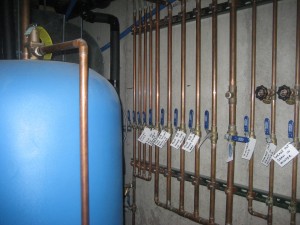 This credit counts in both the performance and prescriptive pathways, because it is not an input in the HERS index rating. The intent is to reduce energy consumption associated with the domestic hot water system, including improving the efficiency of the hot water system design as well as the layout of the fixtures in the home. According to the USGBC, as much as one-third of a home’s total energy bill is spent on heating water — not only for the end use (such as showers), but also in the heat lost through the piping system and storage tank. About 10%-15% of energy use in hot water systems in wasted in distribution losses, so this credit encourages locating fixtures as close as possible to the central hot water heater.
This credit counts in both the performance and prescriptive pathways, because it is not an input in the HERS index rating. The intent is to reduce energy consumption associated with the domestic hot water system, including improving the efficiency of the hot water system design as well as the layout of the fixtures in the home. According to the USGBC, as much as one-third of a home’s total energy bill is spent on heating water — not only for the end use (such as showers), but also in the heat lost through the piping system and storage tank. About 10%-15% of energy use in hot water systems in wasted in distribution losses, so this credit encourages locating fixtures as close as possible to the central hot water heater.
This credit does not reward points for solar hot water tanks, tankless water heaters (both of which we considered), or ground-source heat pump preheat systems (which we do have). Those are either modeled in the HERS index rating, or, if we were to go down the prescriptive path, we would need to submit a Credit Interpretation Request for points.
There are three sub-sections; the first is 7.1 Efficient Hot Water Distribution, worth 2 points. (The others will be addressed in the next blog two postings.) First, we needed to choose one of three designs for the distribution system: a structured plumbing system, a central manifold system, or a compact design of conventional system. We have a structured plumbing system, because it allows for a recirculation loop. For the 2 points, the system must meet all of the following:
- The system must have a demand-controlled circulation loop that is insulated to at least R-4.
- The total length of the circulation loop must be less than 40 linear feet of plumbing in one-story homes. (Add 2x the ceiling height for two-story homes, add 4x the ceiling height for three- or four-story homes.)
- Branch lines from the loop to each fixture must be ≤ 10 feet long and a maximum of 1/2 inch nominal diameter.
- The system must be designed with a push button control in each full bathroom and the kitchen and an automatic pump shut-off.
I must admit that the plumbing system is probably the thing with which I am least familiar. I had to ask our plumbing contractor several times which type of distribution system we were installing. The one thing I did know was that I wanted a recirculation loop, because in our last condo, it used to take at least 3 minutes to get hot water to our shower — and that drove me crazy. It was a waste of water and a waste of energy, and a waste of time, for that matter. Having a recirculating loop fixes this problem, because it slowly pumps hot water through the pipes. Now, our wait time for hot water in the shower is about 3 seconds. I love the recirculating loop! It does take energy to run the pump, but it can be turned off on a timer, and overall it is a net energy saver — in addition to a huge water saver.
The issue in this credit for us is the length of the recirculation loop, and I think this is where design and functionality of the house won out over energy efficiency of our hot water distribution system. Our ceilings are 9 feet, and we are 3 stories, so we get to add 4×9=36 to the 40 linear feet requirement, which gives us 76 feet for the entire recirculation loop. That seems like a lot, but our house is very long and thin. Our hot water heater is located in the mechanical room in the south end of the basement; our master shower is located in the north end of the second floor. Since the length of our house is 62 feet, I don’t even need a measuring tape to know that the full loop has to be longer than 76 feet. We also do not have a push button control in each full bathroom and kitchen to turn off the pump. We considered that, but it was more expensive (and more complicated) than just installing one central timer on pump (see photo). 
While we spent more money for the recirculation pump, I’m not sure how we could have even gotten the points, given the second bullet above. I suppose we could have installed a tankless hot water heater for our master shower and not attached it the recirculation loop; the rest of the hot water demand fixtures would have fallen within the linear foot limit. But doing that would not have allowed us to utilize the hot water tank that is preheated by our ground source heat pump system, and in the end would probably have cost us more in energy bills. So, no points here, and I have no regrets.
Energy & Atmosphere Points so far: 25.5
Cumulative points: 56.5
Additional points needed to get to Gold: 31.5
EA Prescriptive Path points so far: 9
